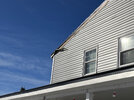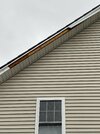Is there a metal fireplace insert or flue? Had you ever tried the pen on the fireplace brick before the PV install? That part is just odd, although not really if there were installed AC wiring behind the brick or walls.
I curious about your 5800 pic. Is that center front facing wall, which looks almost vertical, installed with active tiles? (Not related to your problem, just didn't know they did that, if true.)
I re-read your first post... You mention waiting on a meter and being off-grid? So is your system not connected at all to the main presently? Was everything else wired as far as you know from Tesla? I wonder if there is an actual grounding problem at the main panel/PV side.
The fireplaces are masonry, no metal insert, and may have some metal for structurally tying things together, but overall are just huge masses of dielectric material. My guess is that they are acting like a capacitor somehow. I have two chimney's, four fireplaces (1st and 2nd floor, both sides of the home). Both exhibit this phenomenon and trigger the tester, on both floors. If I shut down the PV system by turning off the inverter breakers, the signals in the walls, celling, chimney, flashing all go away. So their isn't some legacy AC circuit related to the issue. It seems strictly related to the PV.
The 5800 pic is the vertical wall with the dormers, this wall is strictly glass and metal. The closest active tile to that location is the roof above that wall in the MP7 zone. The MP3 zone is also completely separate electrically from both a roof/PV and flashing perspective. The MP3 zone also exhibits flashing that carries a voltage. The 6 other zones are all electrically connected by flashings. The only way in which these two zones are connected is the hard metal conduit on the DC feeder lines, and that metal is grounded at the inverter to house ground. This grounding ends at the junction boxes right before the roof penetration, and I do not believe the roof or flashings are linked to this one ground source.
I am currently off grid and not yet backfeeding. My utility inspection was 12/28/21, and I'm still waiting on the utility to upgrade me to a net metering meterbase. My batteries have also never been fully charged yet, so I'm not in a state where the system is rate limiting due to lack of load.
Although I have a 30.5kW system, the max output I've seen so far is 5kW (instantaneous) / (20.5kW over 9 hrs sunlight), as only zones 3, 6 and 7 currently get any direct sun at this time of year. They total 18.1kW. Upon commissioning the system, Tesla's quality team thought there was a wiring issue because of the low production rate, came out and re-inspected the inverters, made some changes to CT's and then chalked it up to shading instead. (I still have some trees to remove).
Based on production rates and this voltage issue, I personally believe something might still be wired wrong.
Also note, I'm not the original poster of this thread, I just have a very similar situation, and if I had gutters at the moment, I would also expect them to be electrified. Originally I was going to install copper gutters, but this issue now has me greatly concerned that there is a galvanic corrosion issue of dissimilar metals when dealing with a roof like this.





